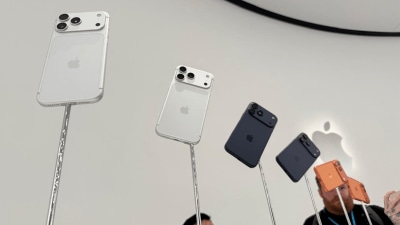On Thursday, the tech giant reported that increasing prices by $100 in September on some of its most popular iPhones paid off with record quarterly revenue and profit. The higher prices helped Apple rake in more money during a period when analysts estimated that the company sold about 1 million more iPhones than a year ago.

Total revenue rose 8 per cent to $102.5 billion from a year earlier, the first time the company has made more than $100 billion during the three months that ended in September. Profit rose 86 per cent to $27.5 billion, after its net income was hit a year ago by a tax payment.
In September, Apple gave customers a reason to buy its newest iPhones by changing their external design. It unveiled a thinner and smaller model called the iPhone Air and overhauled the iPhone Pro to feature a raised bump across its back. The changes helped drive iPhone sales to $49 billion in the quarter, up 6 per cent from last year.
The results topped expectations. Wall Street analysts had predicted quarterly sales of $101.52 billion and profit of $26.34 billion. The company’s shares rose more than 4 per cent in after-hours trading.
Apple’s performance was marred by its business in China, where sales fell 3.6 per cent to $14.5 billion.
The iPhone’s popularity has helped the company continue to wring more money out of users from apps and services like Apple Pay and Google, which pays it about $20 billion annually to automatically fulfill search queries on Apple devices. Services revenue rose 15 per cent to $28.8 billion.
Thomas G. Plumb, president of Wisconsin Capital Management, said that the Google ruling and iPhone 17 have “been a pleasant surprise.” But he added: “They have to show they have a plan to move the needle for the next few years with AI.”
Apple has largely avoided the artificial intelligence arms race. It is not pouring billions of dollars into data centers, developing expensive AI systems or building its own chatbot. It canceled a plan to release a more personalized version of its virtual assistant, Siri, saying the AI product it was developing did not meet its quality standards and needed improvement. The company has said that the product would come next year.
Those stumbles have weighed on Apple’s stock. Shares of Google and Microsoft have soared more than 25 per cent this year, but Apple’s share price has risen a more modest 8 per cent.
This week, the company reached a value of $4 trillion. That was overshadowed Wednesday when Nvidia, the world’s most valuable public company and dominant provider of AI chips, became the first company to be valued at more than $5 trillion.
Last month, Apple caught a break when a federal judge ruled that Google, which had been found to be an internet search monopoly, could continue paying to automatically fulfill search queries on iPhones. The ruling meant that Apple could continue collecting payments from Google, and also opened the door for it to charge AI companies to reach iPhone customers.
Apple posted mixed results from its other main businesses. Mac sales rose 13 per cent to $8.7 billion, but sales of iPads and wearables like the Apple Watch were flat.
President Donald Trump’s trade policy continues to give Apple headaches. The company makes almost all of its products abroad; many of its iPhones are made in China, which has a higher tariff rate than other countries. Though Apple has been producing more iPhones for the United States in India, it had expected to pay $1.1 billion in tariffs in the September quarter.
Apple has promised to invest $600 billion in the United States over the next four years, but it has not committed to manufacturing any of its products in the country.
In August, Tim Cook, Apple’s chief executive, visited the White House and presented Trump with a 24-karat gold plaque. He also lavished the president with praise and committed to buy more semiconductors manufactured in America.
This article originally appeared in The New York Times.







